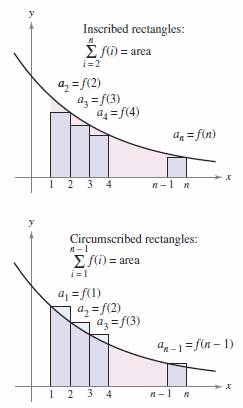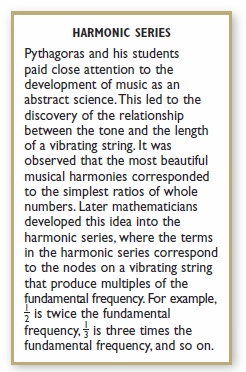Calculus II 09.03 The Integral Test and p-Series
| Previous | Calculus II 09.02 Series and Convergence |
| Next | Calculus II 09.04 Series Comparisons |
Contents
9.3 The Integral Test and p-Series
- Use the Integral Test to determine whether an infinite series converges or diverges.
- Use \(p\)-series and harmonic series properties.
The Integral Test
|
This section and Section 9.4 describe convergence tests that apply to series with positive terms. Theorem 9.3.1 The Integral TestIf \(f\) is positive, continuous, and decreasing for \(x \geqslant 1\) and \(a_{n} = f(n)\), then
either both converge or both diverge.
and
The exact area under the graph for \(f\) from \(x=1\) to \(x=n\) lies between the inscribed and circumscribed areas.
Using the \(n\)th partial sum, \(S_{n}=f(1)+f(2)+f(3)+\cdots+f(n)\), the inequality can be written as
Assuming that \( \int_{1}^{ \infty } f(x)dx\) converges on \(L\), it follows that for \(n \geqslant 1\)
This means the series \( \{ S_{n} \} \) is bounded and monotonic, and by Theorem 9.1.5 it converges. Therefore, \(\sum a_{n}\) converges. When extending the integral to infinity assume that the improper integral diverges. Then \( \int_{1}^{ \infty } f(x)dx\) approaches infinity as \(n \to \infty\), and the inequality \( S_{n-1} \geqslant \int_{1}^{n} f(x)\:dx \) implies that \( \{ S_{n} \} \) diverges. Therefore, \( \sum a_{n}\) also diverges. |
Example 9.3.1 Using the Integral Test
Apply the Integral Test to the series
- $$ \sum_{n=1}^{\infty} \frac{n}{n^{2}+1}.$$
Solution The function \(f(x)=x/(x^{2}+1)\) is positive and continuous for \(x \geqslant 1\). To determine whether \(f\) is decreasing, find the derivative.
- $$f'(x)=\frac{(x^{2}+1)(1)-x(2x)}{(x^{2}+1)^{2}}= \frac{-x^{2}+1}{(x^{2}+1)^{2}} $$
Since \(f'(x) < 0 \) for \(x>1\) it follows that \(f\) satisfies the conditions for the Integral Test. Integrate to produce
| $$\int_{1}^{\infty} \frac{x}{x^{2}+1}dx$$ | $$= \frac{1}{2} \int_{1}^{\infty} \frac{2x}{x^{2}+1}dx $$ |
| $$= \frac{1}{2} \lim_{b \to \infty} \int_{1}^{ b} \frac{2x}{x^{2}+1}dx $$ | |
| $$= \frac{1}{2} \lim_{b \to \infty} \bigg [ \ln (x^{2}+1) \bigg ]_{1}^{b} $$ | |
| $$= \frac{1}{2} \lim_{b \to \infty} [ \ln (b^{2}+1) - \ln 2] $$ | |
| $$= \infty. $$ |
Therefore the series diverges.
Example 9.3.2
|
Apply the Integral Test to the series
Solution The function \(f(x)=1/(x^{2}+1)\) satisfies the conditions for the Integration Test. Applying the test produces
The series converges as shown in Figure 9.3.2. Because the improper integral converges to \(\pi/4\) does not imply that the infinite series also converges to \(\pi/4\). To approximate the sum for the series, use the inequality
The larger \(N\) gets, the better the approximation. For example, using \(N=200\) produces \(1.072 \leqslant \sum 1/(n^{2}+1) \leqslant 1.077\). |
\(p\)-Series and Harmonic Series
|
A \(p\)-series, where \(p\) is a positive constant, has the form
For \(p=1\), the series becomes an harmonic series
A general harmonic series has the form
In music, strings with the same material, diameter, and tension, and whose lengths form a harmonic series, produce harmonic tones. |
Theorem 9.3.2 Convergence in \(p\)-Series
The \(p\)-series
- $$ \sum_{n=1}^{\infty} \frac{1}{n^{p}}= \frac{1}{1^{p}} + \frac{1}{2^{p}} + \frac{1}{3^{p}} + \cdots $$
converges for \(p > 1\), and diverges for \(0 < p \leqslant 1\).
Proof The proof follows from the Integral Test and Theorem 8.8.1, which states that
- $$ \int_{1}^{\infty} \frac{1}{x^{p}}dx$$
converges for \(p > 1\), and diverges for \(0 < p \leqslant 1\).
Example 9.3.3 Convergent and Divergent \(p\)-Series
Describe the convergence or divergence for (a) the harmonic series and (b) the \(p\)-series with \(p=2\).
Solution
a. From Theorem 9.3.2, it follows that the harmonic series
- $$ \sum_{n=1}^{\infty} \frac{1}{n}= \frac{1}{1} + \frac{1}{2} + \frac{1}{3} + \cdots \:\:\: \color{red}{p\text{=1 }}$$
diverges. b. From Theorem 9.3.2, it follows that the \(p\)-series
- $$ \sum_{n=1}^{\infty} \frac{1}{n^{2}}= \frac{1}{1^{2}} + \frac{1}{2^{2}} + \frac{1}{3^{2}} + \cdots \:\:\: \color{red}{p\text{=2 }}$$
converges.
The sum for the series in Example 9.3.3(b) is \(\pi^{2}/6\), Leonhard Euler proved this. The Integral Test does not reveal that the series sum is equal to the integral. Consider Example 9.3.3(b) series has the sum
- $$ \sum_{n=1}^{\infty} \frac{1}{n^{2}} = \frac{\pi^{2}}{6} \approx 1.645 $$
whereas the improper integral has the value
- $$ \int_{1}^{\infty} \frac{1}{x^{2}}dx = 1.$$
Example 9.3.4 Testing a Series for Convergence
Determine whether the series
- $$ \sum_{n=2}^{\infty} \frac{1}{n \ln n} $$
converges or diverges.
Solution This series is similar to the divergent harmonic series. If its terms were greater than those in the harmonic series, expect it to diverge. However,
because its terms are less than those in the harmonic series, we are not sure what to expect. The function
- $$f(x)= \frac{1}{x \ln x}$$
is positive and continuous for \(x \geqslant 2\). To determine whether \(f\) is decreasing, first rewrite \(f\) as
- $$f(x)= (x \ln x)^{-1}$$
and then find its derivative.
- $$f'(x)= (-1)(x \ln x)^{-2}(1+\ln x)= \frac{1+\ln x}{x^{2}(\ln x)^{2}}$$
Therefore, \(f'(x) < 0 \) for \(x>2\) and it follows that \(f\) satisfies the conditions for the Integral Test.
| $$ \int_{2}^{\infty} \frac{1}{x \ln x} dx $$ | $$= \int_{2}^{\infty} \frac{1/x}{\ln x} dx$$ |
| $$= \lim_{b \to \infty} \bigg [ \ln(\ln x) \bigg ]_{2}^{b}$$ | |
| $$= \lim_{b \to \infty} [ \ln(\ln b - \ln(\ln 2) ]$$ | |
| $$= \infty$$ |
The series diverges.
Internal Links
Parent Article: Calculus II 09 Infinite Series


